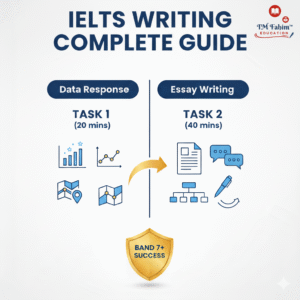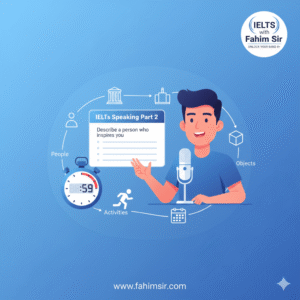“The right vocabulary can turn an average IELTS report into a high-scoring one.”
— Fahim Sir
When it comes to IELTS Writing Task 1, the line graph is one of the most frequently appearing question types. To describe trends accurately and achieve a Band 7 or higher, you need to use varied, formal, and precise vocabulary. This post focuses on the essential words and expressions you should use when describing line graphs effectively.
What Does a Line Graph Show?
A line graph displays how a particular variable changes over time. It might show data like population growth, internet users, sales figures, or unemployment rates.
Your primary goal is clear: to identify and describe overall trends, compare different data sets, and use appropriate tenses and vocabulary to describe change.
Example question: The graph below shows the percentage of mobile phone users in three countries between 2000 and 2020.
Vocabulary for Describing an Increase
Avoid using the same word repeatedly. You must replace “increase” with a range of strong alternatives.
Instead of just saying “Increase,” use terms like Rise, Go up, or Climb. When describing a much faster movement, use powerful words like Soar, Surge, or Escalate. For a quick jump to a high point, you might use Jump or Shoot up.
You must also use adverbs to show the speed or strength of the change, such as sharply, rapidly, steadily, gradually, or significantly.
For instance: “The figure rose steadily in 2010,” or “The sales soared dramatically after 2015.”
Vocabulary for Describing a Decrease
When numbers go down, use these formal alternatives to “decrease”:
Terms like Fall, Drop, or Decline are useful for general downward movement. For a very fast or big fall, use Plummet. For a small dip, you can use Dip, Shrink, or Diminish.
Note: In formal Task 1 reporting, avoid informal expressions like “fall down” or “go lower.”
For instance: “The rate fell slightly between 2012 and 2014,” or “The population plummeted after 2015.”
Vocabulary for Stability (No Change)
Sometimes, the line remains flat. Use these precise expressions to describe stability:
- Remain stable
- Stay constant
- Maintain the same level
- Show no significant change
- Level off
Example: “The unemployment rate remained stable throughout the decade,” or “Internet usage leveled off after 2015.”
Vocabulary for Fluctuations and Peaks
When the trend goes up and down in an irregular pattern, you must describe this movement accurately:
Use verbs like Fluctuate, Vary, or the phrase Be erratic to show an unstable pattern.
Example: “The temperature fluctuated between 20°C and 30°C over the week.”
You also need terms for the highest and lowest points: reach a peak, peak at, hit the highest point, or bottom out, reach a trough, hit the lowest point.
Adjectives and Adverbs to Describe the Degree of Change
To make your writing precise, always combine strong adjectives with adverbs.
- Adverbs (how quickly or slowly): sharply, rapidly, significantly, steadily, gradually, slightly.
- Adjectives (to describe the type of change): a sharp rise, a gradual increase, a slight fall, a dramatic surge.
Example: “There was a gradual increase in 2010, followed by a sharp decline in 2012.”
Vocabulary for Comparing Trends
In most line graphs, you will need to compare two or more lines. Use clear comparison language to link your ideas:
- Use verbs like: outpaced, outnumbered, or surpassed.
- Use linking phrases: In contrast to, Whereas, or While.
- Describe the relationship: The gap widened or narrowed between X and Y.
Example: “The number of female graduates outnumbered males after 2018.” Comparison is a key feature of high-band reports.
Time Expressions for Line Graphs
Use clear time phrases to organize your report chronologically and ensure strong coherence:
- From 2000 to 2010 / Between 2000 and 2010
- Over the next decade
- During the following years
- By the end of the period
- In the early 2000s / mid-2010s / late 2020s
Example: “Internet usage increased steadily from 2000 to 2010 before leveling off.”
Final Thoughts
“IELTS Writing Task 1 is not about complicated grammar — it’s about clarity, accuracy, and strong vocabulary.”
— Fahim Sir
If you want to build confidence and learn how to describe any graph clearly, join IELTS with FAHIM Sir. Both our Crash Course (1 Month) and Regular Course (3 Months) programs include special sessions dedicated to data description and advanced vocabulary training.
Students from Sylhet, Dhaka, and abroad have already achieved Band 7+ using these techniques. Stop wasting time – start training with proven methods today.







1 thought on “IELTS Writing Task 1: Vocabulary for Describing Line Graphs”
Pingback: 🎯 IELTS Writing Task 2: Complete Essay Structures by FAHIM Sir - Fahim Sir